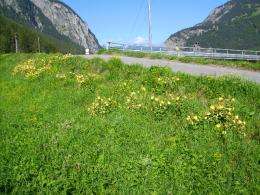Tolerant species more upwardly mobile

Only a few invasive plant species succeed in mountain regions. A team including ETH ecologists have now explained, with a rule that applies all over the world, why some exotics are more successful than others - and they've added a word of warning.
On every continent, conservationists are battling against inadvertently or deliberately introduced non-native species, which often put pressure on and displace native species, threatening to throw ecological balances into confusion. These invaders include countless plant species. New research into the encroachment of exotic species into mountain areas, that have so far largely escaped biological invasion, is giving cause for concern. About 1,000 different imported plant species (neophytes) have already been found in mountain regions around the globe; however, their species richness is greatest at lower to intermediate elevations. The variety of neophytes declines rapidly with increasing altitude. In mountain environments above 1,500 metres altitude, most species are no longer able to become established. The few species that have managed to do so are sufficiently specialised to survive under the extreme conditions of high mountain environments, it was previously assumed.
All-rounders work their way slowly to the top
A wide-ranging study by the MIREN network, coordinated at ETH Zurich, which looked into plant invasion in mountain areas across the globe, turns this assumption on its head. The researchers investigated the neophyte flora along elevational gradients in eight different mountain regions around the world, including Hawaii and Tenerife. And the study showed that it is not non-native species with specialist adaptations to mountain conditions, but instead environmental all-rounders, that make it to the top – therefore, only those 'aliens' that are at home in a broad spectrum of different climates. “Climate is an effective environmental filter that is valid world-wide”, says Jake Alexander, primary author of the study and a post-doctoral researcher at ETH Zurich's Institute for Integrative Biology. Introduced species with narrow environmental niches are weeded out by this filter, whilst those adapted to a broad range of conditions that exhibit a wide environmental tolerance are able to survive and flourish.
The majority of the species the researchers came across in mountain regions came originally from lowland areas, where they originated as ornamental plants or agricultural weeds. In most cases, they spread along transport routes, such as roads and railway lines, because the ecosystem is disturbed at those locations. This makes it easier for alien species to become established, since there is little native competition in such habitats. In Switzerland at least, the spread from low altitudes into the high mountain is a gradual process. So far, only a handful of introduced plant species have scaled these heights.
Invasion risk due to planting of exotic species in mountain regions
However, researchers from MIREN fear that with the expansion of human activities in mountain areas, particularly the development of summer tourism, the spread of invasive plants could increase. Up to now, only very few plants adapted to the extreme climate have been introduced directly into the mountain regions of other continents. But if traffic infrastructure or the grounds of new hotels are planted with non-native mountain plants, this could threaten to create invasions by species already adapted to high altitude conditions. “This hides a serious potential risk that in high mountain elevations, that have thus far escaped biological invasions, the situation could change abruptly”, says Alexander. By this mechanism, human assistance would enable specialised organisms to move directly into the high-elevation environment, without having to work their way up from the valleys. MIREN is therefore calling for strict rules for the introduction and planting of non-native mountain flora.
For their investigation, the researchers recorded all the introduced flora along roadsides and in the immediate vicinity of roads. Transport routes are considered primary axes of distribution along which introduced plant species make their way upwards. As their next project, the MIREN researchers are investigating the occurrence of these non-natives in undisturbed habitats to estimate whether invasive species are also increasingly taking root in mountain areas away from transport routes.
More information: Alexander, J. M., et al. Consortium. 2011. Assembly of non-native floras along elevational gradients explained by directional ecological filtering. Proceedings of the National Academy of Sciences 108:656-661.DOI: 10.1073/pnas.1013136108
McDougall KL, et al. Alien flora of mountains: global comparisons for the development of local preventive measures against plant invasions. Diversity and Distributions (2011) 17, 103-111. DOI: 10.1111/j.1472-4642.2010.00713.x
Provided by ETH Zurich

















